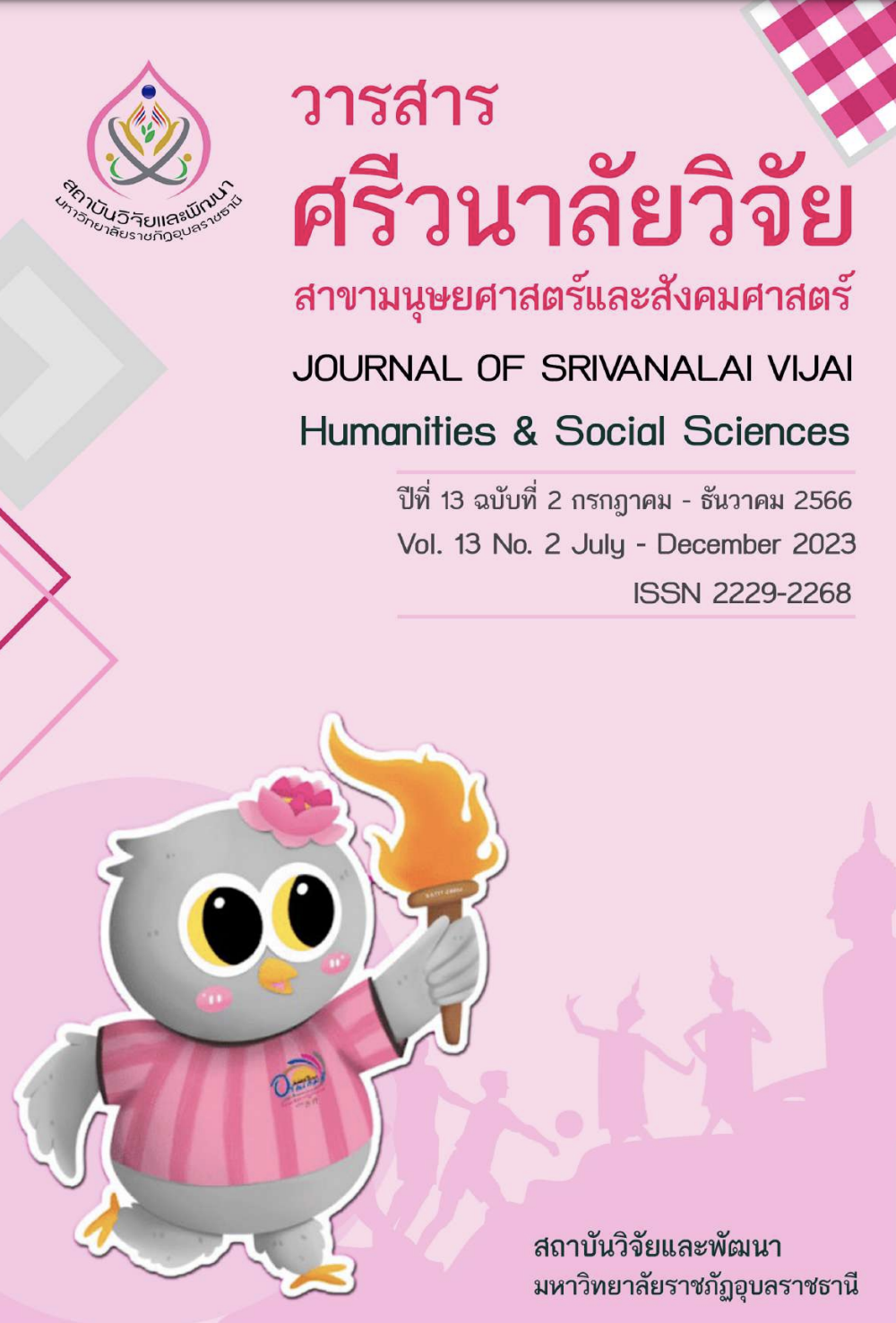ปัจจัยเชิงสาเหตุที่มีอิทธิพลต่อประสทิธิภาพขององค์กรของธุรกิจโรงแรมในภาค ตะวันออกเฉียงเหนือ
Main Article Content
บทคัดย่อ
การวิจัยครั้งนี้เป็นการศึกษาหาความสัมพันธ์เชิงสาเหตุ(Causal Relationship) โดยมีจุดมุ่งหมาย เพื่อศึกษาปัจจัยเชิงสาเหตุที่มีอิทธิพลต่อประสิทธิภาพขององค์กรธุรกิจโรงแรมในภาคตะวันออกเฉียงเหนือ พัฒนา โมเดลความสัมพันธ์เชิงสาเหตุของปัจจัยที่มีอิทธิพลต่อประสิทธิภาพขององค์กรธุรกิจโรงแรมในภาค ตะวันออกเฉียงเหนือ และศึกษาความสอดคล้องของโมเดลความสัมพันธ์เชิงสาเหตุตามสมมติฐาน กับข้อมูลเชิง ประจักษ์ ตัวอย่างในการวิจัยครั้งนี้ คือ ผู้ประกอบการและพนักงาน ของธุรกิจโรงแรมที่มีจานวนห้องพักตั้งแต่ 60 ห้อง ขึ้นไป ในเขตภาคตะวันออกเฉียงเหนือ ซึ่งกาหนดการสุ่มจากเขตพื้นที่จังหวัดในภาคตะวันออกเฉียงเหนือของประเทศ ไทย ได้จานวน 600 ตัวอย่าง จากการสุ่มแบบหลายขั้นตอน (Multi-Stage Sampling) สถิติที่ใช้ในการศึกษาและ วิเคราะห์ข้อมูลของงานวิจัยนี้ ประกอบด้วย สถิติพื้นฐานเพื่อหาค่าแจกแจงความถี่ ค่าร้อยละ ในการวิเคราะห์ข้อมูล สภาพของผู้ตอบแบบสอบถาม พร้อมกับวิเคราะห์ปัจจัยสารวจ(Exploratory Factor Analysis) และการวิเคราะห์ โมเดลสมการโครงสร้าง ประกอบด้วย การวิเคราะห์โมเดลการวัด (Measurement Model) การวิเคราะห์โมเดล โครงสร้าง (Structure Model) เพื่อหาความสอดคล้องของโมเดลสมการโครงสร้างกับข้อมูลเชิงประจักษ์
ผลการวิจัย พบว่า ค่าเฉลี่ยของการพัฒนาทรัพยากรมนุษย์ในรูปแบบการเปลี่ยนแปลง อยู่ในระดับมาก มาก ( ̅ = 3.837) ค่าเฉลี่ยของความสามารถด้านการปรับปรุงอย่างต่อเนื่องอยู่ในระดับมาก ( ̅ = 4.085) ค่าเฉลี่ย ของประสิทธิภาพขององค์กร อยู่ในระดับมาก มาก ( ̅ = 4.136)
ปัจจัยการพัฒนาทรัพยากรมนุษย์ในรูปแบบการเปลี่ยนแปลง โมเดลมีความสอดคล้องกลมกลืนกับ ข้อมูลเชิงประจักษ์ โดยมีค่า ค่า Chi-square = 285.131, df = 89, p = 0.000, Chi-square/df = 3.204, GFI = 0.955, AGFI = 0.931, RMR = 0.007, RMSEA = 0.000 ปัจจัยด้านความสามารถด้านการปรับปรุงอย่างต่อเนื่อง โมเดลมีความสอดคล้องกลมกลืนกับข้อมูลเชิงประจักษ์ โดยมีค่า Chi-square = 910.758, df = 331, p = 0.000, Chi-square/df = 2.752, GFI = 0.916, AGFI = 0.897, RMR = 0.010, RMSEA = 0.000 ปัจจัยด้าน ประสิทธิภาพขององค์กร โมเดลมีความสอดคล้องกลมกลืนกับข้อมูลเชิงประจักษ์ โดยมีค่า Chi-square = 92.422, df = 28, p = 0.000, Chi-square/df = 3.301, GFI = 0.970, AGFI = 0.944, RMR = 0.006, RMSEA = 0.000
การพัฒนาทรัพยากรมนุษย์ในรูปแบบเปลี่ยนแปลงมีอิทธิพลทางตรงต่อประสิทธิภาพขององค์กร มี ขนาดอิทธิพลกับ 1.942 อย่างมีนัยสาคัญทางสถิติที่ระดับ 0.001, ความสามารถด้านการปรับปรุงอย่างต่อเนื่องมี อิทธิพลทางตรงต่อประสิทธิภาพขององค์กรมีขนาดอิทธิพลเท่ากับ0.863 อย่างมีนัยสาคัญทางสถิติที่ระดับ0.05.
และ การพัฒนาอย่างต่อเนื่องมีอิทธิพลทางตรงต่อประสิทธิภาพขององค์กรขนาดอิทธิพลเท่ากับ0.863 อย่างมี นัยสาคัญทางสถิติที่ระดับ .05 ดังนั้น ผลการ วิจัยเป็นไปตามสมมติฐานที่ตั้งไว้ทุกข้อ
Article Details
เอกสารอ้างอิง
กรรณิการ์สุขเกษมและสุชาติประสิทธิ์รัฐสินธุ์. (2544). นานานวตกรรมวิธีวิทยาการวิจัย. กรุงเทพฯ: บริษัท เฟื่องฟ้า พริ้นติ้ง จากัด.
สานักงานคณะกรรมการพัฒนาการเศรษฐกิจและสังคมแห่งชาติ. (2560). แผนพัฒนาเศรษฐกิจและสังคม แห่งชาติ ฉบับที่ 12 (พ.ศ.2560 - 2564), วันที่ค้นข้อมูลมกราคม 4, 2564, เว็บไซด์: https://www.nesdc.go.th/ewt_w3c/more_news.php?filename=&cid=297
สุชาติ ประสิทธิ์รัฐสินธุ์. (2544).ระเบียบวิธีการวิจัยทางสังคมศาสตร์. (พิมพ์ครั้งที่ 11). กรุงเทพฯ: บริษัทเฟื่องฟ้า พริ้นติ้ง จากัด.
Al-Tit, A. A. (2017). Factors affecting the organizational performance of manufacturing firms. International Journal of Engineering Business Management, 9, 1-9.
Arora, P., & Suri, D. (2020). Redefining, relooking, redesigning, and reincorporating HRD in the post Covid 19 context and thereafter. Human Resource Development International, 23(4), 438- 451.
Asiaei, K., Jusoh, R., & Bontis, N. (2018). Intellectual capital and performance measurement systems in Iran. Journal of Intellectual Capital, 19(2), 294-320.
Bessant J., Caffyn S., Gilbert J., Harding R. and Webb S. (1994). Rediscovering CI, Technovation, 14 (1), 17-29.
Bhuiyan, N., & Baghel, A. (2005). An overview of continuous improvement: from the past to the present. Management decision, 43(5), 761-771.
Brockbank, W., Ulrich, D., & Beatty, R. W. (1999). HR professional development: Creating the future creators at the University of Michigan Business School. Human Resource Management, 38, 111-118.
Chapman, R.L. & Hyland, P. (2000). Strategy and continuous improvement in Small-to-Medium Australian Manufacturers, integrated Manufacturing System, 11(3), 171-179.
Akoi, S. M., & Yesiltas, M. (2020). The Impact of Human Resource Development (HRD) Practices on
Interventie Sociala, 70, pp.90-118.
Butler, M., Szwejczewski, M., & Sweeney, M. (2018). A model of continuous improvement programme management, Production Planning and Control, 29(5), 386–402. https://doi.org/10.1080/09537287.2018.14338
Fryer, K., Ogden, S., & Anthony, J. (2013). Bessant's continuous improvement model: revisiting and
revising. International Journal of Public Sector Management, 26(6), 481-494.
วารสารศรีวนาลยั วิจัย ปีที่ 13 ฉบับที่ 2 กรกฎาคม - ธันวาคม 2566
Garavan (2007), A Stgrategic perspective on Human resource development, Advances in Developing Human Resource, 9(1), pg. 11.
Garavan, T. N., Gunnigle, P., & Morley, M. (2000). Contemporary HRD research: a triarchy of theoretical perspectives and their prescriptions for HRD. Journal of European Industrial Training, 24(2), 65-93.
Gilley, J. W., & Gilley, A. M. (2002). Strategically integrated HRD: A six-step approach to creating results-driven programs. Cambridge, MA: Perseus Publishing
Goshu, Y. Y., & Kitaw, D. (2017). Performance measurement and its recent challenge: a literature review. International Journal of Business Performance Management, 18(4), 381-402.
Hair, J.F., Anderson, R.E. & Tatham, R.L. (1995). Multivariate Data Analysis with readings. (4th Ed).
New Jersey: Prentice-Hall.
Hair, J.F., Anderson, R.E., Tatham, R.L. & Black, W. C. (1998). Multivariate Data Analysis. New Jersey:
Prentice-Hall.
Harteis, C. (2018). The Impact of Digitalization in th Workplace. An Educational view. Springer:
Germany.
Jurburg, D., Viles, E., Jaca, C. & Tanco, M. (2015). Why are companies still struggling to reach higher
continuous improvement maturity level? Empirical evidence form high performance
companies, The TQM Journal, 21(3), 316-327.
Khan, S. A., Kaviani, M. A., Galli, B. J., & Ishtiaq, P. (2019). Application of continuous improvement
techniques to improve organization performance: A case study. International Journal of
Lean Six Sigma, 10(2), 542-565.
McLean, R. S., Antony, J., & Dahlgaard, J. J. (2017). Failure of Continuous Improvement initiatives
in manufacturing environments: a systematic review of the evidence. Total Quality
Management & Business Excellence, 28(3-4), 219-237.
Otoo, F. N. K., & Mishra, M. (2018). Measuring the impact of human resource development (HRD)
practices on employee performance in small and medium scale enterprises. European
Journal of Training and Development, 42(7), pp.517-534.
Paipa-Galeano, L., Bernal-Torres, C. A., Otálora, L. M. A., Nezhad, Y. J., & González-Blanco, H. A.
(2020). Key lessons to maintain continuous improvement: A case study of four
companies. Journal of Industrial Engineering and Management, 13(1), 195-211.
Singh, S., Darwish, T. K., & Potočnik, K. (2016). Measuring organizational performance: A case for
subjective measures. British Journal of Management, 27(1), 214-224.
Unzueta, G., Esnaola, A., & Eguren, J. A. (2020). Framework to Evaluate Continuous Improvement Process Efficacy: A Case Study of a Capital Goods Company.Quality Innovation
Prosperity/Kvalita Inovácia Prosperita, 24(2).
You, J., Kim, S., Kim, K., Cho, A., & Chang, W. (2020). Conceptualizing meaningful work and its
implications for HRD. European Journal of Training and Development, 45(1), 36-52.


